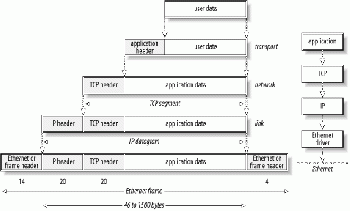Packet switching

Packet switching is a method of grouping data transmitted over a digital network into packets which are composed of a header and a payload. Data in the header is used by networking hardware to direct the packet to its destination where the payload is extracted and used by application software. Packet switching is the primary basis for data communications in computer networks worldwide.[2]
A network packet can hold about 1500 bytes, but this can be changed. is The MTU (Maximum Transmission Unit) for Ethernet, for instance, is 1500 bytes [3]. This might include all the information in a packet (including header and footer information). The data size for a packet might be around 536 bytes.
Simple diagram of a packet[edit]
I use this diagram with gratitude from https://tournasdimitrios1.wordpress.com/2011/01/19/the-basics-of-network-packets/[4]

Simple diagram of an ethernet packet[edit]
I use this diagram with gratitude from http://books.gigatux.nl/mirror/snortids/0596006616/snortids-CHP-2-SECT-2.html[5]
A TCP packet[edit]
I use this diagram with gratitude from http://books.gigatux.nl/mirror/snortids/0596006616/snortids-CHP-2-SECT-2.html[6]
This is how data is transmitted by packet switching:
Network communication is broken down into packets. Every packet has a header and data. The header of a packet contains (among other information) the source and the destination IP address of the packet. The packet is ROUTED to it's destination by a collection of routers, all using an agreed-upon protocol of communication. Packets are reassembled at the destination and de-encapsulated (unzipped) into a network request your operating system (and application) can understand.
The video below shows a good example of this. The video mentions the RIP protocol. The Routing Information Protocol (RIP) is one of the oldest distance-vector routing protocols which employ the hop count as a routing metric. RIP prevents routing loops by implementing a limit on the number of hops allowed in a path from source to destination. [7]
A good introductory video[edit]
Do you understand this?[edit]
If you are still stuck, you may want to ask a question on our discussion board.
See Also[edit]
Standards[edit]
These standards are used from the IB Computer Science Subject Guide[8]
- Explain how data is transmitted by packet switching.
References[edit]
- ↑ http://www.flaticon.com/
- ↑ https://en.wikipedia.org/wiki/Packet_switching
- ↑ https://stackoverflow.com/questions/2613734/maximum-packet-size-for-a-tcp-connection
- ↑ https://tournasdimitrios1.wordpress.com/2011/01/19/the-basics-of-network-packets/
- ↑ http://books.gigatux.nl/mirror/snortids/0596006616/snortids-CHP-2-SECT-2.html
- ↑ http://books.gigatux.nl/mirror/snortids/0596006616/snortids-CHP-2-SECT-2.html
- ↑ https://en.wikipedia.org/wiki/Routing_Information_Protocol
- ↑ IB Diploma Programme Computer science guide (first examinations 2014). Cardiff, Wales, United Kingdom: International Baccalaureate Organization. January 2012.

